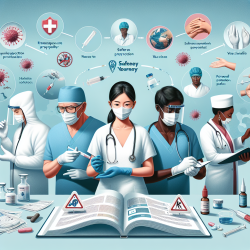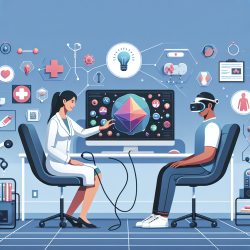Empowering Healthcare Practitioners: A Journey Towards Safer Work Environments
In the ever-evolving landscape of healthcare, ensuring the safety and well-being of healthcare personnel (HCP) is paramount. The research article "Occupational Health Update" by Erica S. Shenoy and David J. Weber sheds light on the critical role of occupational health services (OHS) in safeguarding healthcare workers from infectious diseases. This blog explores how practitioners can enhance their skills by implementing the findings from this research, fostering a safer and more efficient healthcare environment.
Understanding the Risks
Healthcare personnel face numerous risks, including exposure to infectious agents, back injuries, and stress. The research emphasizes the importance of understanding these risks and implementing effective occupational health programs to mitigate them. By educating HCP on proper handling of sharps, early identification and isolation of potentially infectious patients, and adherence to standard and transmission-based precautions, we can significantly reduce the risk of infections.
Key Strategies for Risk Mitigation
The research highlights several key strategies that practitioners can adopt to minimize the risk of communicable disease acquisition:
- Proper Training: Regular training sessions on infection prevention practices and sharp injury prevention are crucial. Ensure that all HCP are well-versed in these practices at the start of their careers and receive annual updates.
- Vaccine Immunity: Ensure that all HCP are immune to vaccine-preventable diseases. This involves regular reviews of immunity status and administration of necessary vaccines.
- Postexposure Prophylaxis (PEP): Evaluate HCP exposed to communicable diseases for PEP and provide appropriate management.
- Standard Precautions: Adhere to standard precautions, including proper hand hygiene, before and after patient care.
- Transmission-Based Precautions: Implement rapid transmission-based precautions for patients with known or suspected communicable diseases.
- Personal Protective Equipment (PPE): Ensure the proper use of PPE, such as masks, respirators, gloves, and gowns, based on the mode of transmission.
Encouraging Further Research
While the research provides a comprehensive framework for improving occupational health, it also opens the door for further exploration. Practitioners are encouraged to delve deeper into specific areas, such as the effectiveness of different PPE types or the psychological impact of occupational health programs on HCP. By engaging in continuous research, healthcare professionals can contribute to the development of more robust and adaptive safety protocols.
Conclusion
Empowering healthcare practitioners with the knowledge and tools to protect themselves and their patients is a vital step towards a safer healthcare environment. By implementing the strategies outlined in the "Occupational Health Update," practitioners can enhance their skills and contribute to a culture of safety and well-being. For those interested in exploring the research further, the original paper provides a wealth of information and insights.
To read the original research paper, please follow this link: Occupational Health Update.










